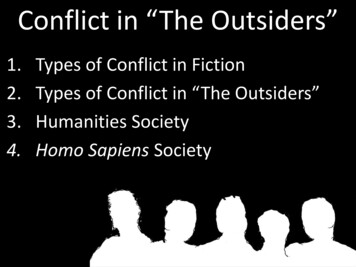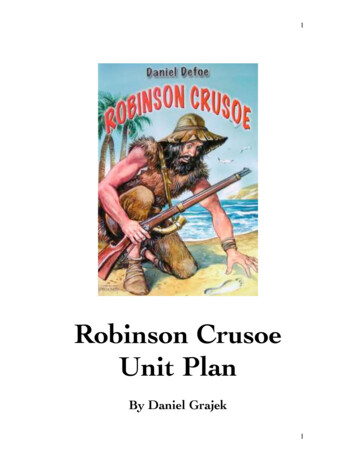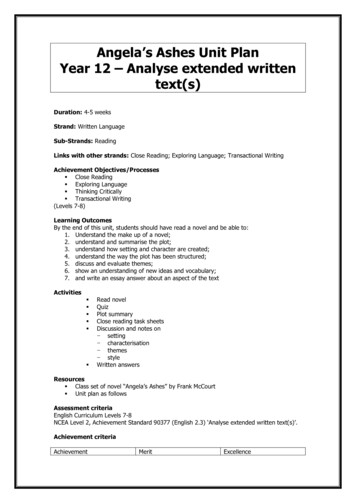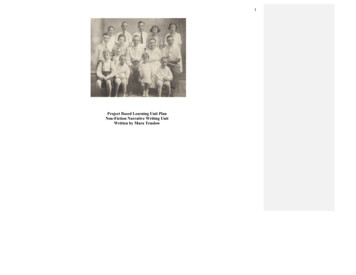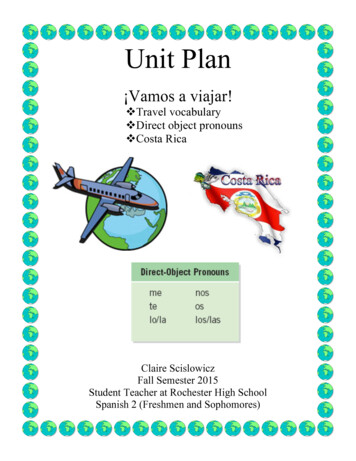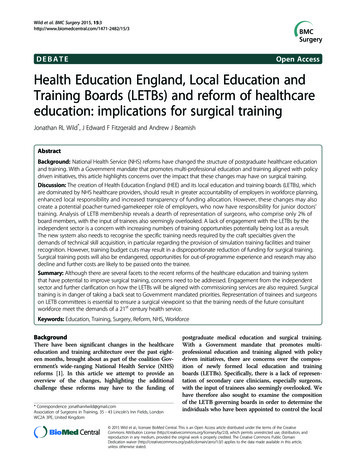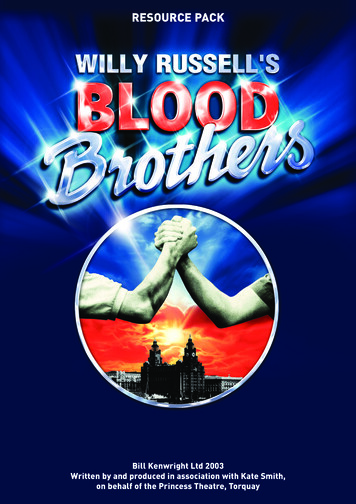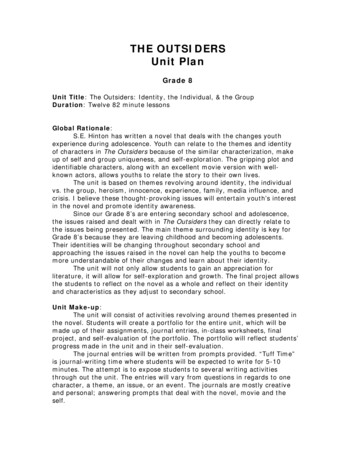
Transcription
THE OUTSIDERSUnit PlanGrade 8Unit Title: The Outsiders: Identity, the Individual, & the GroupDuration: Twelve 82 minute lessonsGlobal Rationale:S.E. Hinton has written a novel that deals with the changes youthexperience during adolescence. Youth can relate to the themes and identityof characters in The Outsiders because of the similar characterization, makeup of self and group uniqueness, and self-exploration. The gripping plot andidentifiable characters, along with an excellent movie version with wellknown actors, allows youths to relate the story to their own lives.The unit is based on themes revolving around identity, the individualvs. the group, heroism, innocence, experience, family, media influence, andcrisis. I believe these thought-provoking issues will entertain youth’s interestin the novel and promote identity awareness.Since our Grade 8’s are entering secondary school and adolescence,the issues raised and dealt with in The Outsiders they can directly relate tothe issues being presented. The main theme surrounding identity is key forGrade 8’s because they are leaving childhood and becoming adolescents.Their identities will be changing throughout secondary school andapproaching the issues raised in the novel can help the youths to becomemore understandable of their changes and learn about their identity.The unit will not only allow students to gain an appreciation forliterature, it will allow for self-exploration and growth. The final project allowsthe students to reflect on the novel as a whole and reflect on their identityand characteristics as they adjust to secondary school.Unit Make-up:The unit will consist of activities revolving around themes presented inthe novel. Students will create a portfolio for the entire unit, which will bemade up of their assignments, journal entries, in-class worksheets, finalproject, and self-evaluation of the portfolio. The portfolio will reflect students’progress made in the unit and in their self-evaluation.The journal entries will be written from prompts provided. “Tuff Time”is journal-writing time where students will be expected to write for 5-10minutes. The attempt is to expose students to several writing activitiesthrough out the unit. The entries will vary from questions in regards to onecharacter, a theme, an issue, or an event. The journals are mostly creativeand personal; answering prompts that deal with the novel, movie and theself.
The final project will allow for students to discover their own identityand relate themselves to a character in the novel. The students will have thefreedom to express their own identity through pieces in the portfolio;journals, artwork, and anything else they wish to submit.Participation will include listening, speaking, interest in assignmentsand novel, completion of assignments and projects, and writing journalentries.Unit Learning Outcomes:- demonstrate an understanding of the main ideas, events, orthemes of a novel, story, poetry, and other print- explain the motivation of the characters in works ofcommunication, providing evidence from the text of each work- identify and explain connections between new ideas andinformation and their previous beliefs, values, and experiences- revise and edit their work to improve content, organization, andeffect to best suit their audience and purpose- demonstrate pride and satisfaction in using language to create andexpress their thoughts, ideas, and feelings- create a variety of academic, technical, and personalcommunications, including poems, stories, personal essays, oraland written reports, group presentations, and informaldramatizations- identify personal strengths and goals related to using language anduse this information to set new goals- use various strategies to resolve conflicts, solve problems, andbuild consensus- evaluate the effectiveness of literary techniques including figurativelanguageUnit Objectives: (SWBAT)- define identity and discover their self-identity- evaluate the dynamics of cliques and gangs and assess if they arenecessary during youth- compare and contrast the 1960s and 2003, in regards to fashion,media, music, movies, etc.- “Tuff Time” journal entries will demonstrate critical thinking andpersonal reflection on the novel and different themes- compare and contrast the Greasers and Socs, and relate the gangsto the groups/cliques at their secondary school- interpret Robert Frost’s poem “Nothing Can Stay Gold?” andanalyze Ponyboy and Johnny’s interpretations- write an autobiography and share personal information aboutfamily, interests, beliefs, etc.- communicate their reflections, ideas, and questions about TheOutsiders and related themes within story- participate in role plays that demonstrate characterization,relationships, and themes throughout novel
-analyze the influence of media in the novel and in societydiscuss crisis and brainstorm effective ways to address a crisis andprovide a variety of crisis-help networkscompare and contrast the movie version of The Outsiders with thenovel by S.E. Hintoncompose a variety of writing assignments relating to themes,characters, identity, and self-identitycreate a portfolio box that portrays their personal identity and theirjournal entries, assignments, and final projectUnit inal Project30%(Comparing Identities: You vs. Who?)Total100%Portfolio: The portfolio will be a collection of students’ work throughout theunit. It will include journal entries (“Tuff Time”), writing assignments,worksheets, and poetry. The portfolio will reflect the progress the studenthas made over the course of the unit by demonstrating their understandingof self-identity and the characters identity in the novel. The portfolio will alsodisplay the student’s writing abilities in different genres. Refer to PortfolioRubrics for evaluation criteria. The portfolio is worth 40% of unit total mark.The portfolio will be out of 100 marks, taking each of the rubric categories(there are 4) and evaluating the student’s portfolio and then multiplying thatnumber by 5. Each section (there are 4) will be marked out of 25, makingthe whole portfolio out of 100 marks.Final Project: The Comparing Identities: You vs. Who? Project will helpstudents discover their own identity and relate themselves to a characterfrom the novel. They will have the freedom to express their own identity inthe genre of their choice. Students are encouraged to analyze a characterand themselves and compare and contrast their identities. (Check rubric forevaluation criteria)Journal: Over the course of the unit, students will write journal entries, “TuffTime”, based on prompts that relate to the novel. They will pick the bestthree journal entries to be read in detail by the teacher and mark those withstickers. The journal will either be personal reflective or reflective towardsthe novels themes and characterization. Each journal entry will be:- a creative experience- 5-10 minutes of writing- not evaluated on grammar, but on thoughtful completion- written from a prompt provided by the teacher
Journal entries are 15% of total mark for unit. The top three journal entries,chosen by the student, will be marked out of 5 each, for a total of 15 marks.Participation: Student’s participation will be evaluated throughout the unit.Participation evaluation will be based on students’ listening skills, speakingskills, interest in unit and assignments, and completion of projects. Student’slistening skills will be evaluated daily through activities, discussion, andassignments. Speaking skills will be evaluated daily as well, through role-playactivities, class discussion, and group presentations. Interest in unit andassignments will be an overall mark based on the entire effort and interestthe student had over the length of the unit and the work ethic placed inassignments and activities. The completion of projects will include handingassignments in on time, and completing the requirements for assignments.Participation is worth 15% of the total unit mark.Activities in Unit:1) Create chart lists about identity, class, race, and cliques2) Provide a shoe box (or other small box) and decorate it with pictures,quotes, whatever of things that identify you – this will become student’sportfolio box3) Self-identity analysis – what makes me who I am?4) “Tuff Time” prompts for journal entries – relating to identity, family,cliques, characterization, media influences, analysis of movie, Greaser vs.Soc5) Group work, East vs. West – chart out the differences and similaritiesbetween the Greasers and Socs6) In groups, students chart out a character through physical characteristics,personality traits, and relationships7) Analyze Robert Frost’s poem “Nothing Can Stay Gold” – students interpretpoem8) Role-Play scenarios involving key characters and key scenes – perform forclass and discuss reactions9) Write a newspaper article from the perspective of a journalist who iseither a Greaser or Soc – students choose between 2 events: a) Johnny’sstabbing of Bob, or b) Johnny and Ponyboy’s rescue of the children in thechurch fire10)In groups, students brainstorm places to go for help when in a crisis,and students brainstorm ways to deal with a crisis on their own – eg. Ifyou were Johnny and Bob and the other Socs were trying to drownPonyboy, what would you do?11)Discuss Johnny’s interpretation to Frost’s “Nothing Can Stay Gold” andrelate it back to the student’s own interpretation of the poem12)Class, group, and partner discussions about themes and issues innovel13)Final Project: An analysis of self and a character in the Outsiders
LESSON 1: Outside Identity!Theme: Identity – Individuality vs. The GroupLearning Outcomes:- demonstrate an understanding of the main ideas, events, orthemes of a variety of novels, stories, poetry, and other print- identify and explain connections between new ideas andinformation and their previous beliefs, values, and experiences- apply various strategies to generate and shape ideasObjectives: (SWBAT)- understand theme of identity- define identity, class, and race- discuss the differences between individuality and group identity- discuss the concepts of cliques and gangsPlan:(1)Hook: “Tuff Time” journal entry, students will write abouttheir personal identity and their group of friends identityWhat is your personal identity? What is your group offriend’s identity?(2)Discussion: Define identity, class, and race, provideexamples(3)Activity 1: Students, in groups of 3 or 4, will be given atopic to brainstorm on chart paper dealing with identity Topics: individuality, cliques, or gangs Students will brainstorm and chart for 10 m.and then present their brainstorm to the class After each topic group(s) has presented, theclass will add more ideas to chart and hangcharts on walls (to be left up for whole unit)(4)Introduction to S.E. Hinton’s novel The Outsiders (handout copies of novel)(5)Activity 2: Discuss with partner what makes you unique(eg. sport activity you participate in, musical instrument)and then your partner is going to introduce you to theclass with your name and what makes you unique(6)Closure: Exit Slip – Define identity. What is the differencebetween individuality and belonging to a clique or gangidentity? Give an example for each. Hand in when done.(7)Homework/Agenda: Read Chapter 1 for next class10 m.10 m.25 m.10-12 m.10 m.10 m.
6 m.Assessment:Activity 1:Activity 2:Students demonstrate their understanding of individuality,cliques, and gangs by brainstormingCan students provide an example of something that makesthem unique?Closure/ Exit Slip: Can students define identity?Can students explain the difference between individualityand clique/group identity?If students can provide an example and definition to the above criteria, wecan assume they understood the concept of identity. If students can find anexample of something that makes them unique, they are able to describe apart of their identity and will be able to discuss in further their self-identity infuture lessons
LESSON 2: The 1960s SettingTheme: Setting and Issues of the 1960sLearning Outcomes:- organize details and information about material they have read,heard, or viewed using a variety of written or graphic forms- identify and discuss various persuasive and advertising strategiesObjectives: (SWBAT)- discuss the setting of the 1960s and the novel- discuss the issues of the 1960s- discuss the differences and similarities of 1960 vs. 2003- readdress identity in terms of the media’s portrayalPlan:(1)Hook: “Tuff Time”, Having read the first chapter of TheOutsiders, what is your impression of the setting,including time period and place? What clues helped youcome to these conclusions?(2)Discuss the ideas & perceptions of setting – focus onclues that lead them to their decisions in “Tuff Time”(3)Present the 1960s era to the students – pictures, icons,music, newspaper headlines, etc.(4)Discussion of 1960s - how does it relate to 2003?Similar/Different?(5)Activity 1: Magazine Worksheet Materials needed: teen magazines (both sexes) Worksheet (attached) Students follow worksheet and pull out ads thatdemonstrate identity of people and gender(6)Chapter 1 – Introduction to story & Ponyboy Who is Ponyboy? Who do we learn about in Chp. 1? Discuss story elements: introduction, setting,mood, and theme What has the story taught us at this point? What is the setting of The Outsiders telling us?(identity, cliques, etc.)(7)Closure: What are 2 differences between the 1960s and2003? 2 Similarities?10 m.5 m.15 m.10 m.25 m.10-12 m.3 m.
(8)Homework/Agenda: Collect Magazine Worksheet thisclass, bring a shoebox or other kind of small box to nextclass2 m.Assessment:“Tuff Time” Discussion:Students discuss setting and what clues in Chapter1 brought them to their conclusion.Activity 1:Look at students’ Magazine Worksheet and the adsthey chose, along with the answers, do theyrepresent a good/bad portrayal
(Check rubric for evaluation criteria) Journal: Over the course of the unit, students will write journal entries, “Tuff Time”, based on prompts that relate to the novel. They will pick the best three journal entries to be read in detail by the teacher and mark those with stickers. The journal will either be personal reflective or reflective towards the novels themes and characterization .
